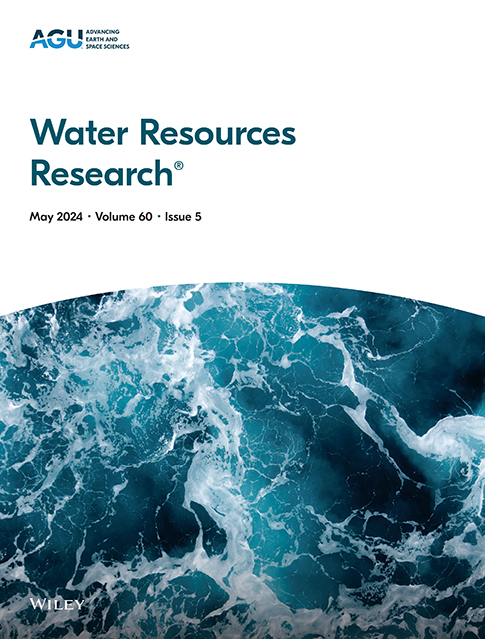综合水流湍流度量,改善下游洄游鱼类的栏架指引
IF 4.6
1区 地球科学
Q2 ENVIRONMENTAL SCIENCES
引用次数: 0
摘要
通过对几种不同形态、游动能力和行为的鱼类进行测试,对最近文献中推荐的最佳棒架系统上游的湍流进行了研究。采用二维双分量和二维三分量最先进的粒子图像测速仪来量化和分析对下游洄游鱼类非常重要的水动力指标。栏杆和齿条的倾角分别为 45° 和 30°,底部覆盖层的厚度为水深的 13%。根据入流速度和横杆厚度,研究的两个雷诺数分别为 4,000 和 6,000。讨论了水深为 5%、流向跨度方向平面上的湍流以及水道中段流向垂直方向平面上的湍流的统计和结构特征。在底部覆盖层的上游,平均流向旁道偏转并加速,导致雷诺应力增加,同时湍流涡旋变小。为有效引导鱼类,建议扫流速度(Vp)大于正常速度(Vn),Vp 平行于栏架和底部覆盖层,Vn 垂直于栏架和底部覆盖层。在栏架的下游半部,Vn 可能会增加到足以超过旁路附近的 Vp,这可能会降低对某些物种和规格的有效指导。在栅栏上游,流向平均速度水平变化突然,可能会阻止鱼类接触栅栏。虽然根据以往的研究可以推断出通过效果,但还需要对不同种类和大小的鱼类进行测试,以确认鱼类的反应。本文章由计算机程序翻译,如有差异,请以英文原文为准。
Comprehensive Flow Turbulence Metrics to Improve Bar Rack Guidance for Downstream Migrating Fish
Turbulent flows are investigated upstream of a bar rack system that is recommended as optimum in recent literature from tests with several fish species of different morphology, swimming ability, and behavior. Both two-dimensional two-component and two-dimensional three-component state-of-the-art particle image velocimetry were used to quantify and analyze hydrodynamic metrics important for downstream migrating species. The inclination angles of the bar and rack were 45° and 30°, respectively, and the thickness of the bottom overlay was 13% of the water depth. The two Reynolds numbers investigated, based on incoming velocity and bar thickness, were 4,000 and 6,000. The statistical and structural characteristics of turbulent flows in the streamwise-spanwise plane at 5% water depth, and the streamwise-vertical plane at channel mid-span are discussed. Upstream of the bottom overlay, the mean flow is deflected and accelerated toward the bypass, leading to an increase in the Reynolds stresses, while the turbulence eddies become smaller. For effective fish guidance, it is recommended that sweeping velocity (Vp) be larger than normal velocity (Vn), with Vp parallel and Vn perpendicular to the bar rack and bottom overlay. In the downstream half of the bar rack, Vn may increase sufficiently to surpass Vp near the bypass, possibly reducing effective guidance for some species and sizes. Upstream of the bars, the levels of streamwise mean velocity vary abruptly, which may deter fish from contacting the bars. Although inferences on passage effectiveness are made based on previous studies, tests with different species and sizes are needed to confirm fish responses.
求助全文
通过发布文献求助,成功后即可免费获取论文全文。
去求助
来源期刊

Water Resources Research
环境科学-湖沼学
CiteScore
8.80
自引率
13.00%
发文量
599
审稿时长
3.5 months
期刊介绍:
Water Resources Research (WRR) is an interdisciplinary journal that focuses on hydrology and water resources. It publishes original research in the natural and social sciences of water. It emphasizes the role of water in the Earth system, including physical, chemical, biological, and ecological processes in water resources research and management, including social, policy, and public health implications. It encompasses observational, experimental, theoretical, analytical, numerical, and data-driven approaches that advance the science of water and its management. Submissions are evaluated for their novelty, accuracy, significance, and broader implications of the findings.
 求助内容:
求助内容: 应助结果提醒方式:
应助结果提醒方式:


